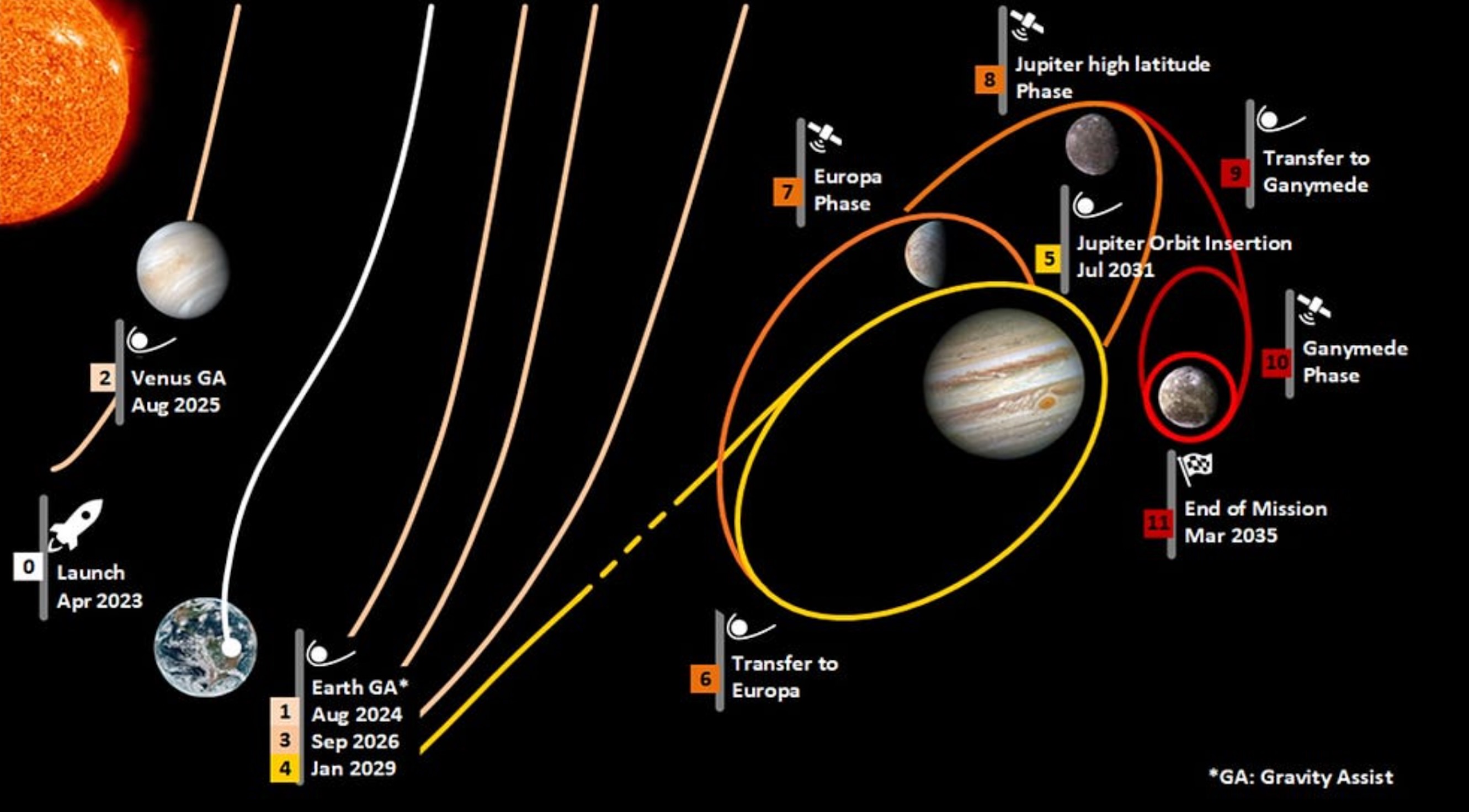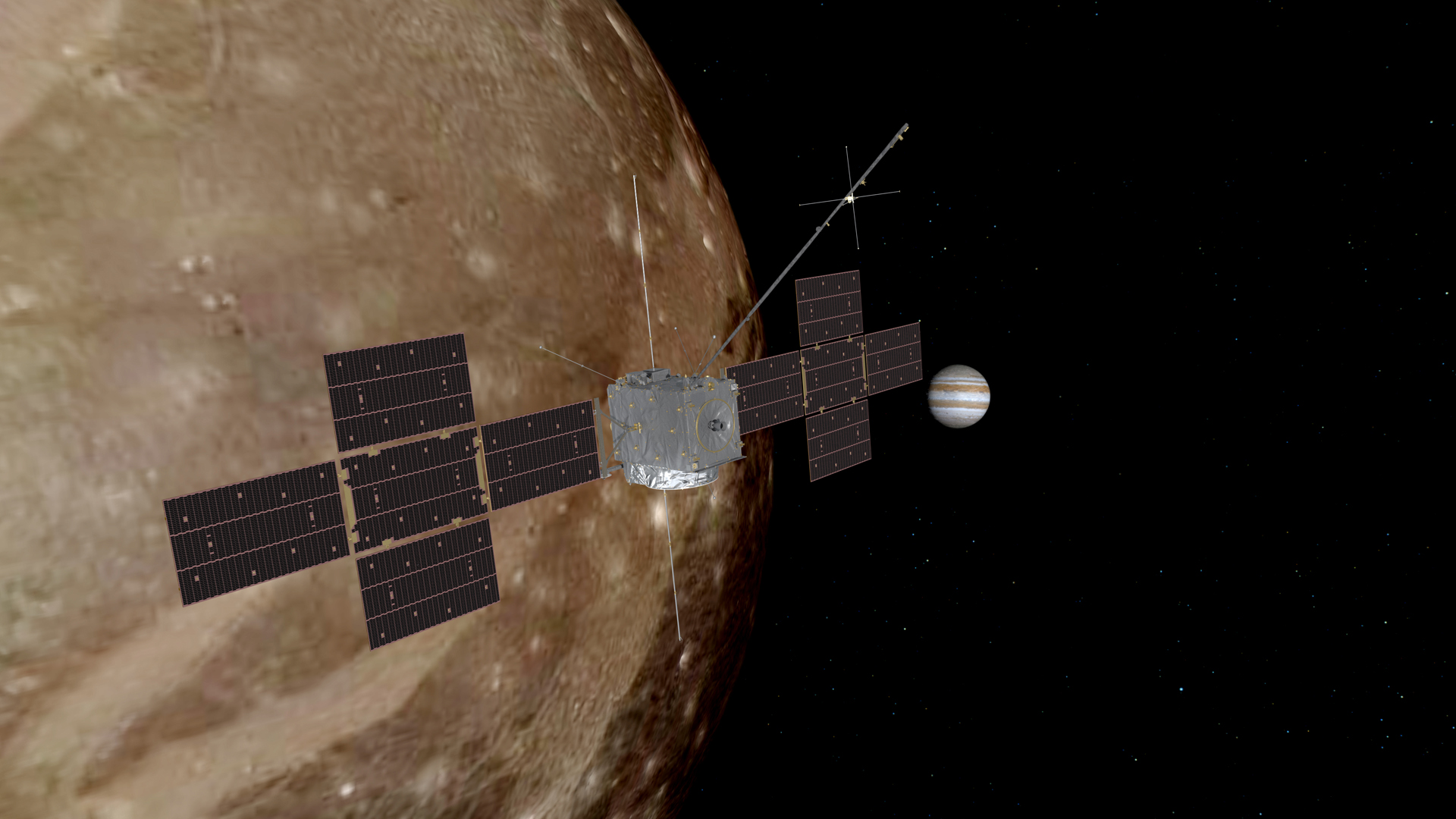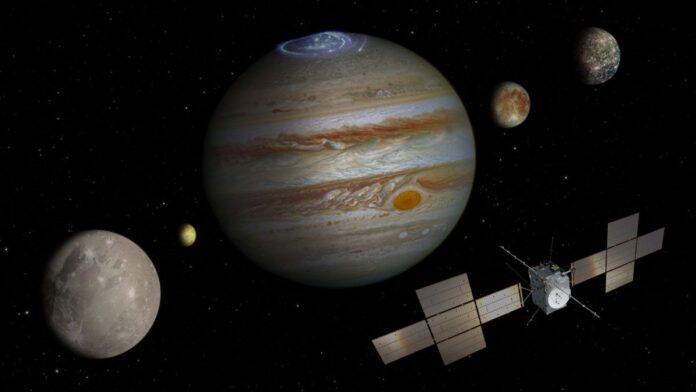On Thursday, April 13, the Jupiter Icy Moons Explorer (JUICE) will lift off from the European Space Agency’s (ESA) spaceport in Kourou, French Guiana, beginning its 8-year journey to the gas giant Jupiter.
When it arrives at the Jovian system in July 2031, the ESA spacecraft will not just investigate the gas giant itself, but will also make observations of its three large ocean-bearing moons.
“We’ll explore Jupiter and its icy moons, which are Europa, Ganymede, and Callisto with a particular focus on Ganymede, which is a unique object in the solar system,” ESA planetary scientist, Olivier Witasse said in an ESA news conference (opens in new tab) on Thursday, April 6. “It is the only moon with a magnetic field and the biggest moon in the solar system. The main goal is to understand whether there are habitable environments among those icy moons and around a giant planet like Jupiter.”
Witasse added that the Jovian system is really like a miniaturized solar system so understanding Jupiter and its moons can help us better understand the solar system as a whole.
Related: ESA’s Jupiter mission JUICE is not ‘strong enough’ to orbit potentially life-harboring Europa. Here’s why
In addition to its important scientific goals, during the course of its journey and mission, JUICE will complete a number of spaceflight firsts for a craft in the solar system, ESA says (opens in new tab).
JUICE will become the first space vehicle to orbit a moon other than that of Earth when it orbits Jupiter’s largest moon Ganymede. JUICE will also be the first spacecraft to switch orbit between a planet and one of its moons.
Even before it gets to Jupiter, JUICE will be making records. During its 8-year trip, it will become the first spacecraft to perform a maneuver called a “gravity assist” using the gravity of Earth and its moon at the same time.
The JUICE spacecraft
JUICE itself has a cube-shaped main body measuring 13.4 by 9.4 by 14.3 feet (4.09 x 2.86 x 4.35 meters). Without fuel, ESA says (opens in new tab), the spacecraft has a mass of 2.65 tons (2.4 metric tonnes), but JUICE will lift off with 4 tons (3.65 metric tonnes) of propellant on board.
The JUICE mission started life as a redesign of the prior Jupiter Ganymede Orbiter proposal, ESA’s contribution to a canceled program called Europa Jupiter System Mission-Laplace (EJSM-Laplace). It was repurposed to form part of ESA’s ESA’s Cosmic Vision 2015–2025 (opens in new tab) program.
JUICE was recommended over other projects in April 2012 such as the proposed Advanced Telescope for High Energy Astrophysics (opens in new tab) (ATHENA) X-ray telescope and the New Gravitational Wave Observatory (NGO). The mission was announced to the public in May of the same year.
“The JUICE spacecraft has taken the better part of the past decade to be designed and developed,” ESA scientist Alessandro Atzei said in the news conference. “We’re talking about a rather large spacecraft with many key features that really are striking.”
ESA says (opens in new tab) that the JUICE mission cost an estimated 1.6 billion Euros ($1.7 billion) and is a product of “global” cooperation between 23 countries, 18 academic institutions, and 83 private companies. About 2,000 people have been involved in the work from designing to getting it to the launch pad.
One of the companies playing a prominent role in the development of JUICE was Airbus Defence and Space, which was announced as the mission’s primary contractor in July 2015.
Airbus science program head Justin Byrne explained that JUICE was built by around 500 engineers from Airbus teams across Spain, the U.K., Holland, and Poland. The engineers in particular had to consider the harsh space environment that the spacecraft will encounter during its mission around Jupiter.
“The JUICE environment is extremely tough,” Byrne said in the news conference. “It has extreme temperatures, very high radiation levels, strong magnetic fields, very, very low light that we need to generate the power the spacecraft needs.”
Collecting sunlight to convert into electrical energy are JUICE’s two “wings” each comprising five panels, each 8.2 by 11.4 foot (2.5 by 3.5 m) in size. ESA says (opens in new tab) that each of these solar array wings can withstand temperatures ranging from a high of 230 degrees Fahrenheit to temperatures as low as minus 382 degrees Fahrenheit (110 degrees Celsius to minus 230 degrees Celsius).
Byrne added the instruments carried by JUICE are very complex, and very sensitive, producing lots of data that must be sent back to Earth. These instruments include the most powerful remote sensing, geophysical, and in situ payload devices ever flown to the outer solar system beyond Mars, according to ESA.
The package includes ten instruments such as the Gravity and Geophysics of Jupiter and Galilean Moons (3GM) radio package that will study the gravity field at Ganymede, the extent of the internal oceans on the icy Jovian moons, the Radar for Icy Moons Exploration (RIME) ice-penetrating radar, and the JANUS camera system that will map the clouds of Jupiter and processes occurring across its moons.
Many of these instruments are magnetically sensitive and will be held away from the main body of JUICE by a 34.8-foot-long (10.6 m) deployable boom. JUICE also has several 10-foot-long (3 m) booms mounted on the body of the spacecraft itself in a tetrahedral configuration. Some pieces of JUICE’s payload are outfitted with their own antennas ranging from 52.5 to 8.2 feet (16 to 2.5 m) in length. These are in addition to the main large dish antenna on one face (Juice’s High Gain Antenna).

The journey to Jupiter
During its 8-year journey, JUICE will save on propellent by making four gravity assists taking energy from planets Earth and Venus as well as Earth’s moon to put itself on a trajectory to reach Jupiter
According to an ESA timeline (opens in new tab), JUICE will get its first gravity assist in August 2024 returning to Earth and collecting energy from the Earth/moon system. Officially called a Lunar-Earth gravity assist (LEGA), this will be the first time such a maneuver will be performed.
“The first one [gravity assist] will be very challenging because it will be not just an Earth gravity assist but a lunar/Earth gravity assist which means that we have to pass by Earth and the moon at the same time,” Atzei added. “So this will be the most accurate gravity assist maneuver ever done.”
For its next gravity assist in August 2025, JUICE will head to the second planet from the sun and Earth’s neighbor, Venus, before returning to our planet for its next two gravity assists in September 2026, and January 2029 respectively.
The JUICE spacecraft will arrive at Jupiter in July 2031 but its science mission will begin around six months before entering orbit around the giant planet, according to ESA (opens in new tab), as it will make observations of the system on its approach.

What is JUICE’s mission?
The JUICE mission will focus on two key themes of ESA’s Cosmic Vision 2015–2025 (opens in new tab) program, namely on the conditions for planet formation and the emergence of life and on the workings of the solar system.
To answer these questions, the spacecraft will make 35 flybys of three of Jupiter’s four main moons (opens in new tab), examining the wider Jovian system and characterizing the gas giant’s atmosphere, magnetic environment, ring system, and smaller satellites. This series of flybys will see JUICE buzzing Europa twice in July 2032 searching for pockets of liquid water under its icy shell. The spacecraft will also hunt for previously detected plumes of water vapor from this Jovian moon.
During several flybys of Callisto, JUICE will study the cratered and ancient surface of this moon, which may also possess a subsurface ocean. These flybys will allow JUICE to shift its orbit which will be important for the spacecraft to get to high latitudes over Jupiter during the period between 2032 and 2034.
After three years orbiting the gas giant, in December 2034 (opens in new tab), JUICE will perform a daring switch between the planet and one of its moons, the first time a spacecraft from Earth will attempt such a move. At this point, the mission will begin characterizing the ocean, icy shell, composition, surface, environment, and activity of Ganymede.
One of the key elements of these investigations will be the hunt for habitability conditions, but this is very distinct from the search for life.
“We are not going to detect life with JUICE,” Witasse said. “We are going to study interesting aspects related to life and habitability. And in particular, this question about water vapor in the very tenuous atmosphere of the moon.”
Witasse added that one of the most important elements of the JUICE mission in terms of scientific objectives is its extremely broad and multi-disciplinary role. That doesn’t mean that the ESA scientist can’t highlight the aspect of the mission he is most excited about.
“We have really a lot to do to satisfy the goals of the scientific community, but if I had one objective to highlight, it is the need to know more about the liquid water underneath the surface of the icy moons,” Witasse said. “It’s quite fascinating to think that underneath these icy surfaces, there is a lot of liquid water, and that will be really the most interesting aspect of the mission.”
All good things come to an end and JUICE is set to meet its demise a year after entering orbit about Ganymede in 2035. At this point, the craft should have run out of propellant and will “deorbit” plummeting towards the icy surface of the solar system’s largest moon, making a grazing impact on Ganymede.
Follow us on Twitter @Spacedotcom (opens in new tab) or on Facebook (opens in new tab).

